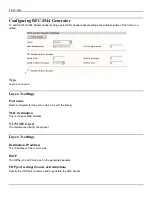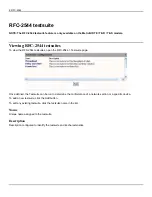
8: RFC-2544
Mbps and perform a dichotomist algorithm between 800 and 1000 (and a granularity of 10) to find the highest rate for
which there is no frame loss. The frame loss setting defines the acceptable difference between measured frame losses.
For example, a setting of 1 would mean a 0.1% frame loss would be acceptable and considered as no frame loss by the
test. The default value is 0, which means absolutely no frame loss is the target for defining full throughput. The Frame
Size parameters let the user choose which frame sizes are to be tested. By default, the 10000 byte frame size (Jumbo
frame) is unselected as it was not a frame size defined by the RFC-2544 standard, but which Accedian supports
nevertheless.
Trial duration
The Trial duration parameter defines the length during which throughput will be analyzed and during which no frame loss
shall occur.
Maximum rate
The Maximum rate defines the upper bound of rates to search for while the Step size defines the granularity of the range.
Minimum rate
The Minimum rate defines the lower bound of rates to search for while the Step size defines the granularity of the range.
Step size
The Step size defines the granularity of the range.
Frame loss
The frame loss setting defines the acceptable difference between measured frame losses.
Delay and delay variation settings
Once a wirespeed rate with no frame loss has been defined by the throughput test, the delay and delay variation test will
measure the latency and jitter at that specific rate. If the throughput test has not been run prior to the delay test, the NID
will perform a short throughput test first (based on the throughput settings). The frame loss setting defines the acceptable
difference between measured frame losses. For example, a setting of 1 would mean a 0.1% frame loss would be
acceptable and considered as no frame loss by the test. The default value is 0, which means absolutely no frame loss is
the target for defining full throughput. The Frame Size parameters let the user choose which frame sizes are to be tested.
By default, the 10000 byte frame size (Jumbo frame) is unselected as it was not a frame size defined by the RFC-2544
standard, but which Accedian supports nevertheless.
Trial duration
The Trial duration is the duration for which the test will be run.
Frame loss
The frame loss setting defines the acceptable difference between measured frame losses.
Frame loss settings
The Frame loss test will verify that no frames are being lost for a duration of time, at two consecutive rates. The test will
run for each Frame size selected, for a duration defined by Trial duration. The Step size indicates the step between each
rate being tested. The NID will start at the Maximum rate defined in the throughput settings and step down by the value
set in the Step size parameter of the Frame loss settings. Two consecutive rates must be frame loss less in order to
successfully pass this test. For example, if the DUT is able to perform full wirespeed at GigE, the test will run at 1000
Summary of Contents for EtherNID EE
Page 8: ...8 Alarms 199 1 APPENDIX B MIB SUPPORT 203 Public MIBs 203 Private MIBs 205...
Page 71: ...4 Port configuration...
Page 121: ...6 Alarms Alarm configuration The Alarm Configuration page lists all defined alarms...
Page 164: ...9 Performance Assurance Agent 3 Configure parameters and click Apply...
Page 191: ...11 CFM 10 Open the CFM DMM Configuration and select add...
















































